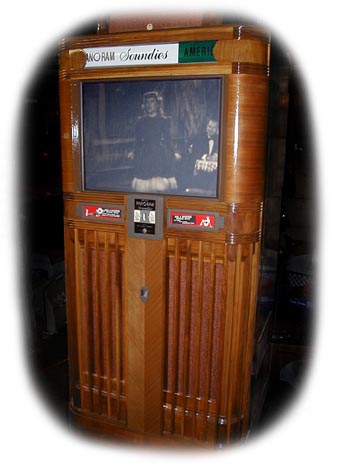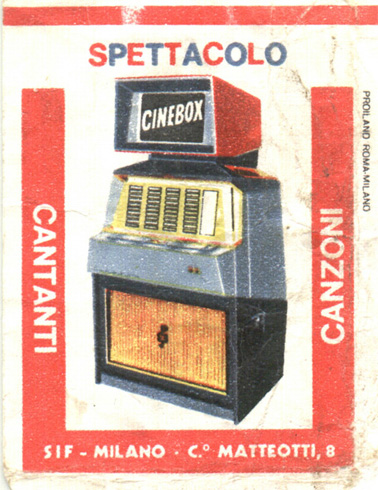
‘This is a Mills Panoram. This fantastic machine was first produced in 1939 by the Mills Novelty Company of Chicago, Illinois. The fabulous wood cabinetry houses a 16mm projector that plays special continuous loop films (Soundies) that typically show jazz and other musicians of the day.’ – via jayandwanda.com
Picture yourself in your favorite tavern. You’ve had a couple cocktails. You drift over to the Panoram, drop in a dime. The 24″ screen comes alive with action. You’re taken to a world of sound and vision.
Happy Feet – Edited as a soundie, 1941
From the 1930 film, ‘King of Jazz’
Bing Crosby and The Rhythm Boys (Harry Barris and Al Rinker)
One of the few color soundies.
Panoram was all about the music. In 1941, Soundies attempted to introduce the comedy sketch but the viewers weren’t convinced – they wanted their machine music. From 1940 to 1947 the Panoram could be found anywhere people congregated – soda shops, taverns, restaurants, bus and train stations, etc. WWII slowed the production of soundies – but some 1800 had been produced in a six year period. The popularity of television would lead to the Panoram’s ultimate demise.
Fast forward to France, 1960. Enter the Scopitone. With similar technology as the Panoram – but this time equipped with a magnetic soundtrack – the 16mm music film jukebox begins a comeback.
The popularity of the Scopitone spread across Europe, the UK, and the States. The content, known as scopitones, combined creative visual expression with modern and pop music in particular. It’s in this way that they have come to be known as the forbears of the music video phenomena that emerged via MTV in 1981. The Scopitone faded from the scene by the end of the sixties. Fortunately, many of the gems have been preserved and can still be appreciated today.
Robot performed by The Tornados, c. 1964
Produced by Joe Meek
The Cinebox was another visual music jukebox that appeared in ’59 – ’60. This one was produced by an Italian company, Ottico Meccanica Italiana.
Cinebox didn’t catch on like scopitones – the works are fewer and more difficult to find. Below is a Cinebox film from the highly unusual, Screaming Lord Sutch. It was produced in 1963 and its influences to future visual music recordings are significant.
SCREAMING LORD SUTCH – Jack The Ripper (Cinebox film, 1963)
For the people of the time, visual jukeboxes presented a novel and interesting way to experience music and other entertainments. Musicians who would never be known on a large scale found a medium that afforded them the opportunity to reach out to more people. As it turns out, that reach has spread across the decades.
For an extensive list of Soundie films, visit the Romano-Archives here. For all things Scopitone and Cinebox, visit the Scopitone Archive here.


LOVE these
LikeLike
They’re really neat. I would love to have a game room with one of these in the corner. 🙂
LikeLike
that really would be hip !!!!!!! 🙂
LikeLike
Reblogged this on muscleheaded and commented:
Retro cool video devices !!!!!
LikeLike